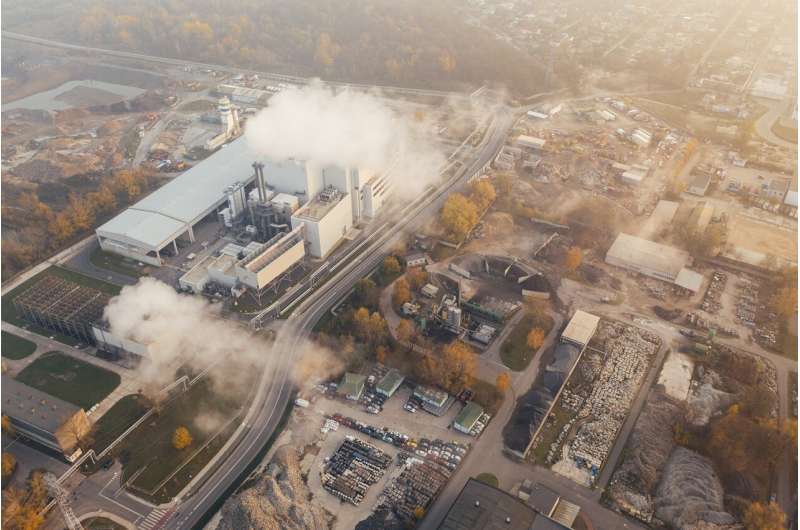Is the future of carbon-capture technology electrochemistry?

Humans send millions of tons of carbon dioxide (CO2) into the air each year—by generating electricity, manufacturing products, driving, flying and doing other routine activities. And while plants can absorb some of that CO2, much of it remains suspended in the atmosphere, where it acts as an insulating blanket that traps heat on Earth.
Scientists believe removing some of that CO2—and either putting it in long-term storage or converting it into something useful—is a potential option for slowing the progression of human-caused climate change. But carbon sequestration, as the process is known, is easier said than done.
Research from the University of Colorado Boulder, however, offers new insights into one promising method for removing carbon from the atmosphere: Using electricity to manipulate chemicals so they can pull carbon out of the air.
Scientists revealed the results of their experiments on a family of compounds known as quinones in a new paper published recently in the journal Energy Advances. By using electrochemical techniques to change their molecular structures, the researchers find that quinones can indeed bind with and capture carbon in a controlled fashion.
Not only does this finding represent a significant and novel discovery in the field of chemistry, researchers say, but it also helps scientists understand more about which types of compounds might be better—or worse—at capturing carbon out of the air.
These electrochemically activated quinone molecules behave differently when capturing carbon from air-like conditions—where CO2 is diluted among many other gases—versus from concentrated CO2 sources, such as those emitted at power plants.
Scientists have long assumed quinone molecules always bound with two CO2 molecules each, operating on a 1:2 ratio. But the CU Boulder researchers find that when capturing carbon from dilute sources, which they've nicknamed "starvation conditions," quinones only bind with one CO2 molecule each—a ratio of 1:1.
"Electrochemical carbon capture materials that are considered to be good for CO2 capture from concentrated sources might not be as good when capturing CO2 from dilute sources such as air," says study co-author Oana Luca, an assistant professor of chemistry at CU Boulder and a faculty fellow at the CU Boulder Research & Innovation Office.
Harnessing the power of electrochemistry for good
Power plants produce roughly 31% of all CO2 emissions—and about 24% of all greenhouse gas emissions—in the United States, per the U.S. Environmental Protection Agency. That's because power plants primarily burn fossil fuels like coal and natural gas to generate electricity, a process that produces large quantities of CO2.
Currently, most of the carbon sequestration that does happen occurs at these plants, which are equipped with special equipment that can grab CO2 before it's discharged into the atmosphere. However, the process is energy-intensive and expensive, as well as limited to specific sites.
It's also not widely used: By some estimates, current carbon sequestration efforts capture just 0.1% of global CO2 emissions each year. To help slow the progression of climate change and limit global warming to the Paris Agreement goal of 2.7 degrees Fahrenheit (1.5 degrees Celsius), that number needs to increase both quickly and dramatically—and Luca is confident electrochemistry can help.
Luca and her collaborators hope that by unlocking the secrets of electrochemical processes, they might someday bring carbon capture and sequestration to the masses. Eventually, they hope that anyone, anywhere, could operate a small device that pulls CO2 out of the air.
"Our method does open the door to a system that could be deployable in your backyard—it could be something you put next to your house or maybe even your car," she says. "It will ultimately be cheaper, and it would also be more easily distributed around, to places where concentrated sources of CO2 are not present. In many ways, it could change the way we do business."
Researchers also hope to eventually figure out how to convert CO2 into useful chemicals. Today, most sequestered carbon gets stored underground in geologic formations.
Their vision is still many years away from becoming a reality. But, nevertheless, the researchers are encouraged by the discoveries and progress they are making in the lab.
"We're not at the point of building devices and saving the world, but we are very excited to have contributed some knowledge about materials that could be considered candidates for direct-air carbon capture," says Luca.
"We're going to get to a point where we can't undo the damage that is being done to our global environment, so that's the reason we do this work—to try to do something about it and try to contribute ideas to formulate some solutions down the line."
















